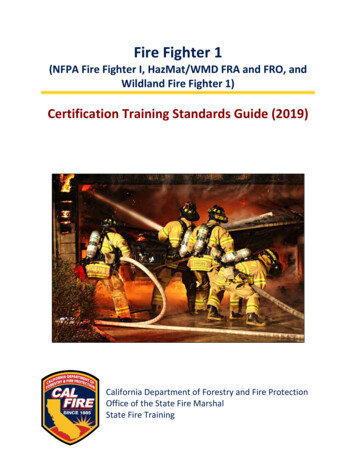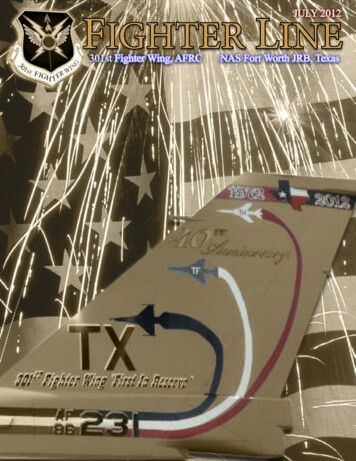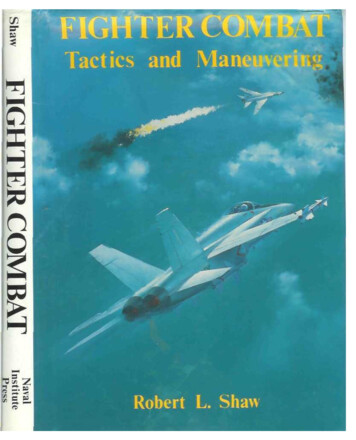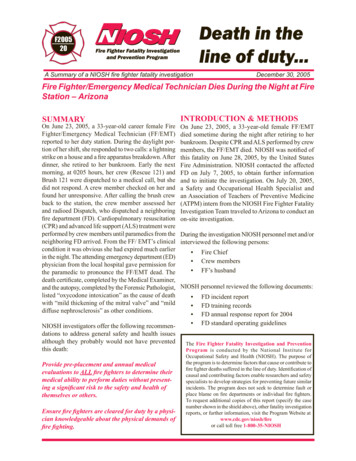
Transcription
Fire Fighter 1(NFPA Fire Fighter I, HazMat/WMD FRA and FRO, andWildland Fire Fighter 1)Certification Training Standards Guide (2019)California Department of Forestry and Fire ProtectionOffice of the State Fire MarshalState Fire Training
Fire Fighter 1Certification Training Standards Guide (2019)Published: January 2020Revised: December 2020This CTS guide utilizes the following NFPA standards to provide the qualifications for State FireTraining’s Fire Fighter 1 (2019) certification: NFPA 1001: Standard for Fire Fighter Professional Qualifications (2019) NFPA 1051: Standard for Wildland Firefighting Personnel Professional Qualifications(2020) NFPA 1072: Standard for Hazardous Materials/Weapons of Mass Destruction EmergencyResponse Personnel Professional Qualifications (2017)State Fire Training coordinated the development of this CTS guide. Before its publication, theStatewide Training and Education Advisory Committee (STEAC) and the State Board of FireServices (SBFS) recommended this CTS guide for adoption by the Office of the State FireMarshal (OSFM).Cover photo courtesy of Craig Allyn Rose Photography.Published by State Fire Training.
Table of ContentsTable of ContentsAcknowledgements. 1How to Read a CTS Guide . 3Fire Fighter 1 - Structure. 5Section 1: Structure Fire Fighter Duties. 51-1: Role of the Fire Fighter 1 . 51-2: Inspecting and Maintaining Personal Protective Equipment. 71-3: Inspecting and Maintaining Self-Contained Breathing Apparatus. 81-4: Donning Structural Personal Protective Equipment . 91-5: Donning Self-Contained Breathing Apparatus . 101-6: Doffing Self-Contained Breathing Apparatus . 111-7: Doffing Personal Protective Equipment . 121-8: Doffing Self-Contained Breathing Apparatus and Personal Protective Equipment forGross Decontamination . 131-9: Identifying Confined Spaces . 141-10: Operating within the Incident Command System . 161-11: Fire Fighter Physical Health and Safety . 171-12: Behavioral Health . 181-13: Cancer Awareness . 19Section 2: Fire Department Communications . 212-1: Initiating the Response to a Reported Emergency. 212-2: Receiving a Telephone Call . 222-3: Transmitting and Receiving Messages via Radio. 232-4: Activating an Emergency Call of Assistance . 24Section 3: Fire Ground Operations . 253-1: Using Self-contained Breathing Apparatus During Emergency Operations. 253-2: Responding on an Apparatus to an Emergency Scene. 273-3: Establishing and Operating in Work Areas at Emergency Scenes. 283-4: Forcing Entry into a Structure. 293-5: Exiting a Hazardous Area . 303-6: Setting Up, Mounting, Ascending, Dismounting, and Descending Ground Ladders. 313-7: Attacking a Passenger Vehicle Fire. 333-8: Extinguishing Fires in Exterior Class A Materials . 353-9: Conducting a Search and Rescue in a Structure. 373-10: Attacking an Interior Structure Fire. 393-11: Performing Horizontal Ventilation on a Structure . 423-12: Performing Vertical Ventilation on a Structure. 433-13: Overhauling a Fire Scene . 453-14: Conserving Property . 473-15: Connecting a Fire Department Pumper to a Water Supply . 493-16: Extinguishing Incipient Class A, Class B, and Class C Fires. 51
Table of Contents3-17: Operating Emergency Scene Lighting. 523-18: Turning Off Building Utilities . 533-19: Combatting a Ground Cover Fire. 543-20: Tying Knots Appropriate for Hoisting Tools . 553-21: Operating Hand and Power Tools. 563-22: Operating an Air-Monitoring Instrument. 57Section 4: Preparedness and Maintenance . 584-1: Cleaning and Checking Ladders, Ventilation Equipment, SCBA, Ropes, SalvageEquipment, and Hand Tools. 584-2: Cleaning, Inspecting, and Returning Fire Hose to Service. 60Hazardous Materials/WMD . 61Section 5: Awareness. 615-1: Description of Duties (Awareness) . 615-2: Recognizing and Identifying Hazardous Materials/WMD and Associated Hazards. 625-3: Isolating the Hazard Area and Denying Entry. 645-4: Initiating Required Notifications . 65Section 6: Operations. 666-1: Description of Duties (Operations). 666-2: Identifying the Scope of a Hazardous Materials/WMD Incident . 676-3: Identifying Action Options for a Hazardous Materials/WMD Incident. 696-4: Performing Assigned Tasks at a Hazardous Materials/WMD Incident . 716-5: Performing Emergency Decontamination at a Hazardous Materials/ WMD Incident. 736-6: Evaluating and Reporting Progress for a Hazardous Materials/WMD Incident. 75Section 7: Operations – Mission Specific. 767-1: Selecting, Donning, Working In, and Doffing Approved PPE at a HazardousMaterials/WMD Incident . 767-2: Performing Product Control Techniques at a Hazardous Materials/WMD Incident . 78Wildland Fire Fighter 1. 80Section 8: Wildland Fire Fighter Duties . 808-1: Role of the Wildland Fire Fighter. 808-2: Donning Wildland Personal Protective Equipment. 828-3: Deploying a Fire Shelter. 838-4: Doffing Wildland Personal Protective Equipment. 84Section 9: Preparedness . 859-1: Maintaining Assigned Personal Protective Equipment . 859-2: Maintaining Assigned Suppression Hand Tools and Equipment. 869-3: Maintaining Personal Gear Kit. 87Section 10: Suppression. 8810-1: Assembling and Preparing for Response. 8810-2: Recognizing Hazards and Unsafe Situations. 8910-3: Constructing a Fireline. 9110-4: Securing the Fireline . 9310-5: Reducing the Threat of Fire Exposure to Improved Properties . 94
Table of Contents10-6: Mopping Up a Fire Area. 9510-7: Patrolling the Fire Area. 96Revisions . 97
AcknowledgmentsAcknowledgementsState Fire Training appreciates the hard work and accomplishments of those who build the solidfoundation on which this program continues to grow. State Fire Training gratefullyacknowledges the following individuals and organizations for their diligent efforts andcontributions that made the development and publication of this document possible.CAL FIRE Thom Porter, DirectorMike Richwine, Acting State Fire MarshalAndrew Henning, Chief of State Fire TrainingJohn Binaski, Chair, Statewide Training and Education Advisory Committee; Chief, ClovisFire Department (STEAC)Cadre – 2019 Development CadreLeadership Jim Eastman, Cadre Lead, Training Specialist III (RA), CAL FIRE; Deputy Chief (ret.),Sacramento Metro Fire DepartmentAllison L. Shaw, Editor, California State University, SacramentoMembers Greg Belk, Division Chief, CAL FIRE San DiegoPaul Gonzalez, Fire Engineer, San Jose Fire Department; Coordinator, South Bay RegionalFire AcademyGarrett Huff, Battalion Chief, Santa Barbara County Fire Department; Secretary, SouthDivision, CalChiefs Training OfficersDonavan Lacy, Battalion Chief, Anderson Fire Protection District; Director of FireTechnology/EMS, Shasta Community College; Area 2 Director, CalChiefs Training OfficersAndrew Murtagh, Lieutenant, San Francisco Fire Department; Adjunct Faculty, FireTechnology Program, College of San MateoMichael Massone, Fire Captain, San Diego Federal Fire; Vice President, CaliforniaProfessional Fire Fighters; Representative, California Joint Apprenticeship CommitteeGerman Sierra, Fire Fighter/Paramedic (ret.), Oakland Fire Department; Faculty –Program Coordinator, Las Positas College; Representative, California Fire TechnologyDirectors’ Association (CFTDA)Shawn Tukua, Captain, Los Angeles Fire Department; State Fire Training Coordinator;Area 15 Director, CalChiefs Training OfficersRob Wheatley, Division Chief, Director of Fire Training, CAL FIRE Training CenterRevised December 2020Page 1 of 98
AcknowledgmentsAugust 2020 RevisionRevised to align Wildland Fire Fighter 1 content with release of NFPA 1051 (2020). Allison L. Shaw, Editor, California State University, SacramentoRevised December 2020Page 2 of 98
How to Read a CTS GuideHow to Read a CTS GuideOverviewA certification training standard (CTS) guide lists the requisite knowledge, skills, and jobperformance requirements an individual must complete in order to become certified in aspecific job function.It also documents and justifies the OSFM-approved revisions to the certification’s NFPAstandard, and identifies where each certification training standard is taught (course plan),tested (skill sheets), and validated (task book).Individuals aspiring to meet State Fire Training’s certification training standards must do so inaccordance with the codes, standards, regulations, policies, and standard operating proceduresapplicable within their own agency or jurisdiction.FormatEach certification training standard is comprised of eight sections.Section HeadingTraining standards are grouped by section headings that describe a general category. Forexample, the Fire Fighter 1 CTS guide includes the following section headings: NFPARequirements, Fire Department Communications, Fireground Operations, and Preparednessand Maintenance.Training Standard TitleThe training standard title provides a general description of the performance requirementcontained within the individual standard.AuthorityThe CTS guide references each individual standard with one or more paragraphs of thecorresponding National Fire Protection Association (NFPA) Professional Qualifications. Thisensures that each fire service function within California's certification system meets or exceedsNFPA standards.When California requirements exceed the NFPA standard, the CTS guide cites the Office of theState Fire Marshal as the authority and prints the corresponding information in italics.Job Performance RequirementsThis segment includes a written statement that describes a specific job-related task, the itemsan individual needs to complete the task, and measurable or observable outcomes.Revised December 2020Page 3 of 98
How to Read a CTS GuideRequisite KnowledgeThis segment lists the knowledge that an individual must acquire in order to accomplish the jobperformance requirement.Requisite SkillsThis segment lists the skills that an individual must acquire in order to accomplish the jobperformance requirement.Content ModificationThis table documents and justifies any revisions to the NFPA standard that the development orvalidation cadres make during the development of a CTS guide.Cross ReferenceThis table documents where each training standard is taught (course plan), tested (skill sheets),and validated (task book).Revised December 2020Page 4 of 98
Fire Fighter 1 - StructureSection 1: Structure Fire Fighter DutiesFire Fighter 1 - StructureSection 1: Structure Fire Fighter Duties1-1: Role of the Fire Fighter 1AuthorityNFPA 1001: Standard for Fire Fighter Professional Qualifications (2019) Paragraph 4.1.1, 4.1.2Job Performance RequirementThere is no job performance requirement identified for this training standard.Requisite Knowledge1.2.3.4.Describe the organization of the fire departmentDescribe the role of the Fire Fighter 1 in the organizationDescribe the mission of fire serviceDescribe the fire department’s standard operating procedures (SOPs) and rules andregulations as they apply to the Fire Fighter 15. Describe the value of fire and life safety initiatives in support of the fire department missionand to reduce fire fighter line-of-duty injuries and fatalities6. Identify the role of other agencies as they relate to the fire department7. Identify the signs and symptoms of behavioral and emotional distress8. Identify aspects of the fire departments’ member assistance program9. Describe the importance of physical fitness and a healthy lifestyle to the performance of theduties of a fire fighter10. Define the critical aspects of NFPA 1500Requisite Skills1. Don personal protective clothing, doff personal protective clothing, perform field reductionof contaminants, and prepare for reuse2. Hoist tools and equipment using ropes and the correct knot3. Locate information in departmental documents and standards or code materialsContent ModificationBlockRevised December 2020ModificationJustificationPage 5 of 98
Fire Fighter 1 - StructureSection 1: Structure Fire Fighter DutiesCross ReferenceCourse PlanSkill Sheet(s)Fire Fighter 1A, Topic 1-3: Fire Fighter 1 Roles Cognitive only – noand Responsibilitiestestable skills RK 1, 2, 3, 4, 5, 6 and RS 3Fire Fighter 1A, Topic 2-2: Health and SafetyAwareness RK 9, 10Fire Fighter 1A, Topic 2-3: Behavioral Healthand Cancer Awareness RK 7, 8Fire Fighter 1A, Topic 2-4: PersonalProtective Ensemble RS 1Fire Fighter 1A, Topic 4-1: Utilizing Ropes andKnots RS 2Revised December 2020Task BookCognitive only – notestable skillsPage 6 of 98
Fire Fighter 1 - StructureSection 1: Structure Fire Fighter Duties1-2: Inspecting and Maintaining Personal Protective EquipmentAuthority1. Office of the State Fire MarshalJob Performance RequirementInspect and maintain structural personal protective equipment (PPE), given PPE, so that PPE isinspected, maintained, and returned to a ready state.Requisite Knowledge1.2.3.4.5.6.Identify the components of structural PPEExplain the importance of standards for structural PPEDescribe how improper usage or maintenance can compromise PPE effectivenessDescribe proper method for inspecting, cleaning, and maintaining structural PPEIdentify when to remove PPE from serviceDescribe how to remove PPE from serviceRequisite Skills1. Inspect structural PPE2. Clean structural PPE3. Maintain structural PPEContent ModificationBlock ModificationCTSAdded a certificationtraining standard.Cross ReferenceJustificationNFPA 1001 does not include a designated JPR for inspectingand maintaining PPE but it is a Cal/OSHA requirement: 8 CCR§ 3401(b)(4).Course PlanFire Fighter 1A, Topic 2-4: StructuralPersonal Protective EnsembleRevised December 2020Skill Sheet(s)1-7: Doff, Inspect, and PrepareStructural PPE for ReuseTask Book(CTS 1-2)Page 7 of 98
Fire Fighter 1 - StructureSection 1: Structure Fire Fighter Duties1-3: Inspecting and Maintaining Self-Contained Breathing ApparatusAuthority1. Office of the State Fire MarshalJob Performance RequirementInspect and maintain self-contained breathing apparatus (SCBA), given SCBA, so that SCBA isinspected, maintained, and returned to a ready state.Requisite Knowledge1.2.3.4.5.6.Identify the components of SCBAExplain the importance of standards for SCBADescribe how improper fit, usage, or maintenance can compromise SCBA effectivenessIdentify the proper method for inspecting, cleaning, and maintaining SCBAIdentify when to remove SCBA from serviceDescribe how to remove SCBA from serviceRequisite Skills1. Inspect SCBA2. Clean SCBA3. Maintain SCBAContent ModificationBlock ModificationCTSAdded a certificationtraining standard.Cross ReferenceJustificationNFPA 1001 does not include a designated JPR for inspectingand maintaining SCBA but it is a Cal/OSHA requirement: 8 CCR§ 5144(k).Course PlanFire Fighter 1A, Topic 2-5: Self-Contained Breathing ApparatusRevised December 2020Skill Sheet(s)1-3: Inspect SCBATask Book(CTS 1-3)Page 8 of 98
Fire Fighter 1 - StructureSection 1: Structure Fire Fighter Duties1-4: Donning Structural Personal Protective EquipmentAuthority1. Office of the State Fire MarshalJob Performance RequirementDon structural personal protective equipment (PPE), given PPE, so the PPE is donned in 60seconds or less and all elements of the PPE ensemble are worn in accordance with manufacturerguidelines.Requisite Knowledge1. Describe the protection provided by structural PPE2. Describe the limitations of structural PPE3. Identify manufacturer guidelines for correct PPE useRequisite Skills1. Don PPEContent ModificationBlock ModificationCTSAdded a certificationtraining standard.Cross ReferenceJustificationNFPA 1001 does not include a designated JPR for donningPPE. OSFM uses 60 seconds as the industry standard.Course PlanSkill Sheet(s)Fire Fighter 1A, Topic 2-4: Structural Personal Protective 1-4: Don Structural PPEEnsembleRevised December 2020Task Book(CTS 1-4)Page 9 of 98
Fire Fighter 1 - StructureSection 1: Structure Fire Fighter Duties1-5: Donning Self-Contained Breathing ApparatusAuthority1. Office of the State Fire MarshalJob Performance RequirementDon self-contained breathing apparatus (SCBA), given SCBA, so that the SCBA is donned in 60seconds or less and all elements of the SCBA are worn and operated in accordance withmanufacturer guidelines.Requisite Knowledge1.2.3.4.5.6.Identify conditions that require respiratory protectionDescribe the protection provided by SCBADescribe the uses and limitations of SCBADescribe potential long-term consequences of exposure to products of combustionIdentify manufacturer guidelines for correct SCBA useDescribe operational inspection procedures for SCBARequisite Skills1. Don SCBA2. Perform operational inspection of SCBAContent ModificationBlock ModificationCTSAdded a certificationstandard.Cross ReferenceJustificationNFPA 1001 does not include a designated JPR for donningSCBA. OSFM uses 60 seconds as the industry standard.Course PlanFire Fighter 1A, Topic 2-5: Self-ContainedBreathing ApparatusRevised December 2020Skill Sheet(s)1-5: Don SCBATask Book(CTS 1-5)Page 10 of 98
Fire Fighter 1 - StructureSection 1: Structure Fire Fighter Duties1-6: Doffing Self-Contained Breathing ApparatusAuthority1. Office of the State Fire MarshalJob Performance RequirementDoff self-contained breathing apparatus (SCBA), given SCBA, so that SCBA is removed inaccordance with manufacturer guidelines and returned to a ready state.Requisite Knowledge1. Identify when it is safe to doff respiratory protection2. Identify manufacturer guidelines for doffing SCBA3. Identify AHJ policies and procedures for doffing SCBARequisite Skills1. Doff SCBA2. Return SCBA to a ready stateContent ModificationBlock ModificationCTSAdded a certificationtraining standard.Cross ReferenceJustificationNFPA 1001 does not include a designated JPR for doffingSCBA but it is a California requirement: 8 CCR § 5144(k).Course PlanFire Fighter 1A, Topic 2-5: Self-Contained Breathing ApparatusRevised December 2020Skill Sheet(s)1-6: Doff SCBATask Book(CTS 1-6)Page 11 of 98
Fire Fighter 1 - StructureSection 1: Structure Fire Fighter Duties1-7: Doffing Personal Protective EquipmentAuthority1. Office of the State Fire MarshalJob Performance RequirementDoff structural personal protective equipment (PPE), given PPE, so that PPE is removed inaccordance with manufacturer guidelines and returned to a ready state.Requisite Knowledge1. Identify when it is safe to doff PPE2. Identify manufacturer guidelines for doffing PPE3. Identify AHJ policies and procedures for doffing PPERequisite Skills1. Doff PPE2. Return PPE to a ready stateContent ModificationBlock ModificationCTSAdded a certification trainingstandard.Cross ReferenceCourse PlanFire Fighter 1A, Topic 2-4: StructuralPersonal Protective EnsembleRevised December 2020JustificationNFPA 1001 does not include a designated JPR fordoffing PPE.Skill Sheet(s)1-7: Doff, Inspect, and PrepareStructural PPE for ReuseTask Book(CTS 1-7)Page 12 of 98
Fire Fighter 1 - StructureSection 1: Structure Fire Fighter Duties1-8: Doffing Self-Contained Breathing Apparatus and Personal ProtectiveEquipment for Gross DecontaminationAuthority1. Office of the State Fire MarshalJob Performance RequirementDoff self-contained breathing apparatus (SCBA) and structural personal protective equipment(PPE), given SCBA and PPE, so that SCBA and PPE are removed to reduce contaminant exposure;SCBA and PPE undergo gross decontamination and are tagged and transported; and fire fighterconducts physical decontamination as soon as possible, in order to reduce exposure to fieldcontaminates.Requisite Knowledge1.2.3.4.5.6.7.Identify the purpose and benefits of gross decontaminationIdentify parts of the body most susceptible to contaminate exposureIdentify common routes of exposureDescribe how to conduct onsite gross decontaminationDescribe how to doff SCBA and PPE to reduce exposure to field contaminantsDescribe how to tag and transport contaminated SCBA and PPEIdentify personal decontamination processesRequisite Skills1. Don and doff SCBA and PPEContent ModificationBlock ModificationCTSAdded acertificationtraining standard.Cross ReferenceJustificationNFPA 1001 does not include a designated JPR for PPE grossdecontamination. Added to incorporate IAFF Cancer Awarenessand Prevention Initiative to increase awareness and promotecultural change.Course PlanFire Fighter 1A, Topic 2-7: Doffing SCBAand PPE for Gross DecontaminationRevised December 2020Skill Sheet(s)1-8: Doff SCBA and PPE for GrossDecontaminationTask Book(CTS 1-8)Page 13 of 98
Fire Fighter 1 - StructureSection 1: Structure Fire Fighter Duties1-9: Identifying Confined SpacesAuthority1. Office of the State Fire MarshalJob Performance RequirementIdentify a permit-required and non-permit-required confined space, given an incident and aconfined space, so that hazards associated with confined spaces are identified, equipment issecured, and incident management operations and communications are followed, in accordancewith state regulations and industry standards.Requisite Knowledge1. Identify regulations and standards applicable to confined space incidents2. Describe the history and dangers of confined space incidents3. Describe how to identify a confined space4. Describe how to identify a permit-required confined space5. Describe how to recognize hazards6. Describe how to isolate hazards and minimize risks7. Describe how to recognize the need for and manage support resources8. Describe how to ensure that resource application fits the operational requirements9. Describe how to recognize the need for technical rescue resources10. Describe how to search areas immediately adjacent to the space11. Describe how to establish victim communication12. Describe how to determine a victim survivability profile13. Describe how to evaluate a non-entry rescue14. Describe how to perform a non-entry rescue15. Describe the positions and components of a permit-required confined space entry16. Describe Cal/OSHA confined space operational positions and responsibilitiesRequisite Skills1. None requiredContent ModificationBlock ModificationCTSAdded a certification trainingstandard.Cross ReferenceCourse PlanCSRA: Confined-Space Rescue Awareness(2018)Revised December 2020JustificationCalifornia state law (8 CCR § 5157-5158) not capturedby NFPA 1001.Skill Sheet(s)Covered in CSRA training materialsTask Book(CTS 1-9)Page 14 of 98
Fire Fighter 1 - StructureSection 1: Structure Fire Fighter DutiesThe training for this standard can be met through the completion of State Fire Training’sConfined Space Rescue Awareness course.Revised December 2020Page 15 of 98
Fire Fighter 1 - StructureSection 1: Structure Fire Fighter Duties1-10: Operating within the Incident Command SystemAuthority1. Office of the State Fire MarshalJob Performance RequirementOperate within the Incident Command System (ICS), given an incident and an incident actionplan, so that organizational elements are recognized, positions and responsibilities areidentified, facility needs are met, and the incident is managed, in accordance with state andfederal regulations.Requisite Knowledge1. Explain the principles and basic structure of the Incident Command System (ICS)2. Describe the NIMS management characteristics that are the foundation of the ICS3. Describe the ICS functional areas and the roles of the Incident Commander and CommandStaff4. Describe the General Staff roles within ICS5. Identify how NIMS management characteristics apply to ICS for a variety of roles anddiscipline areasRequisite Skills1. None requiredContent ModificationBlock ModificationCTSAdded acertification trainingstandard.Cross ReferenceJustificationThis California state law is not captured by NFPA 1001: 19 CCR §2403. See also: Homeland Security Presidential Directive, HSPD5, Section 502, of the Homeland Security Act, 6 U.S.C. §§ 101 et.seq.Course PlanSkill Sheet(s)Fire Fighter 1A, Topic 2-1: Operating within Covered in other training modulesthe Incident Command SystemTask Book(CTS 2-1)The training for this standard can be met through the completion of FEMA’s IS-100:Introduction to the Incident Command System and IS-700: An Introduction to the NationalIncident Management System.Revised December 2020Page 16 of 98
Fir
Fire Department (STEAC) Cadre - 2019 Development Cadre . Leadership Jim Eastman, Cadre Lead, Training Specialist III (RA), CAL FIRE; Deputy Chief (ret.), Sacramento Metro Fire Department Allison L. Shaw, Editor, California State University, Sacramento . Members Greg Belk, Division Chief, CAL FIRE San Diego










